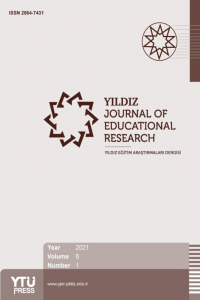Abstract
The purpose of this study is to determine whether life satisfaction and positive-negative affect predicts self concealment in Adolescent at a meaningful level.The sample of the study consists of students, who are studying 9th, 10th and 11th grades of Three different high schools existing in city center of Başakşehir/İstanbul. Totaly 303 students, including 9th, 10th, 11th students, par- ticipate in this study. These students 163 (%53.8) were females and 140 (46.2) were males who with age range 14 to 18,and mean age 16. These students were selected by employing random group sampling. It has been observed that 28% (85) of the students is 9th grade; 24.8% (75) of the students is 10th grade; 24% (73) is 11th grade; 23% (70) is 12th grade. The relational survey method was administered in this study. Self-concealment Scale was developed by Larson and Chastain (1990) and adapted by Deniz ve Çok (2010). Positive-Negative Affect Scale was devel- oped Watson et al. (1988) and adapted by (Gençöz, 2000). Life Satisfaction Scale was developed by Diener, Emmons, Laresen ve Griffin (1985) and adapted by (Köker, 1991). In order to deter- mine the socio-demographic characteristics of the individuals participating in the research, a personal information form was created by the researchers. In the Personal Information Form, the participants were asked about their grade level, their age and gender. Results indicated that the scores of the life- satisfaction and positive-negative affect is found to significantly predict self- concealment score. According to the findings obtained as a result of the research, there is significant relationship between life satisfaction score and self concealment score (r=-0.23, R2=0.055, p<0.01). According to the analyzes carried out in the research life satisfaction explains 5.5 percent of total variance associated with self- concealment. With The data analysis made as a result of the research there is significant relationship between positive- negatif affect and self concealment score (positive affect-self concelment r=-11, p≤0.05,negative affect-self conceal- ment r=0.39, p<0.01, R2=0.155, p<0.01). Positive- negative affect explains as a whole 15.5 per- cent of total variance associated with self- concealment. These results show that life satisfaction and positive-negative affect of adolescents have a significant effect on self concealment.
References
- Çelik,E.(2015). Kendini Gizleme ve Yaşam Doyumu Arasındaki İlişkide Heyecan Arayışının Aracılık Ve Moderatör Rolü, Eğitim ve Bilim, (40)181, 349-361.
- Deniz, M. (2010). Ergenlerde sır saklamanın duygusal ve gelişimsel değişkenler açısından incelenmesi. Doktora Tezi, Ankara Üniversitesi Eğitim Bilimleri Enstitüsü, Ankara.
- Deniz, M., & Çok, F. (2010). Psychometric properties and adaptation of the self-concealment scale to the turkish adolescents. Elementary Education Online, 9(1), 424-432.
- Deniz, M.E., Arslan, Ç., Özyeşil, Z. &İzmirli, M.(2012). Öz-Anlayış, Yaşam Doyumu, Negatif ve Pozitif Duygu: Türk ve Diğer Ülke Üniversite Öğrencileri Arasında Bir Karşılaştırma. Mehmet Akif Ersoy Üniversitesi Eğitim Fakültesi Dergisi,(12) 23,428 – 446.
- Doğan,T. & Eryılmaz, A. (2013). İki Boyutlu Benlik Saygısı ve Öznel İyi Oluş Arasındaki İlişkilerin İncelenmesi. Pamukkale Üniversitesi Eğitim Fakültesi Dergisi,33(1),107-117.
- Eryılmaz, A. & Aypay,A.(2011). Ergenlerin derse katılmaya motive olmaları ile öznel iyi oluşları arasındaki ilişkinin incelenmesi,Uluslararası İnsan Bilimleri Dergisi,(8)1.
- Finkenauer, C., & Rime, B. (1998). Socially shared emotional experiences vs. emotional experiences kept secret: Differential characteristics and consequences. Journal of Social and Clinical Psychology, 17(3), 295-318.
- Finkenauer, C., Engels, R. C., Meeus, & W. (2002). Keeping secrets from parents: Advantages and disadvantages of secrecy in adolescence. Journal of Youth and Adolescence, 31(2), 123-136.
- Fridlander, A., Nazem, S., Fiske, A., Nadorff, M. R. & Smith, M. D. (2012). Self-concealment and suicidal behaviors. Suicide and Life-Threatening Behavior, 42(3), 332-340.
- Frijns, T. & Finkenauer, C., (2008). Longitudinal associations between keeping a secret and psychosocial adjustment in adolescence. International Journal of Behavioral Development. 33 (2), 145–154
- Gençöz T. (2000). Pozitif ve negatif duygu ölçeği: Geçerlik ve güvenirlik çalışması. Türk Psikoloji Dergisi, 15(46), 19-26.
- Gündoğdu,R. & Yavuzer,Y. (2012). Eğitim Fakültesi Öğrencilerinin Öznel İyi Oluş Düzeylerini ve Psikolojik İhtiyaçlarının İncelenmesi. Uluslararası Yükseköğretim Kongresi:Yeni Yönelişler ve Sorunlar 27-29 Mayıs 2011, İstanbul;3(14),1889-1895.
- Ichiyama, M. A., Colbert, D., Laramore, H. , Heim, M., Carone, K. & Schmidt, J. (1993). Self-concealment and correlates of adjustment ın college students. Journal of College Students Psychotherapy, 7, 55–68.
- Karasar, N.(2003). Bilimsel Araştırma Yöntemi. Ankara: Nobel yayın Dağıtım.
- Kelly, A. E. (1998). Clients’ secret keeping in outpaitent therapy. Journal of Counseling Psychology, 45, 50-57.
- Kolsallayan,A., Altok, K.A. & Köksal,A.(2015).Mükemmeliyetçilik ve Başarı Hedeflerinin Sporcuların İçinde Bulundukları Olumlu-Olumsuz Duygu Durumlarını Belirlemedeki Rolü,Spor Bilimler Derneği Mersin Üniversitesi.
- Koydemir, & S., Schütz,A. (2014). Almanya’ da Türk Göçmenlerde Yaşam Doyumu: Kültürel Kimlik ve Benlik Kurgularının Rolü. Türk Psikolojik Danışma ve Rehberlik Dergisi, 5(42),208-220.
- Özbay,Y.,Terzi,Ş.,Erkan,S. & Cihangir-Çankaya,Z.(2011).ÜniversiteÖğrencilerinin Profesyonel Yardım Arama Tutumları, Cinsiyet Rolleri ve Kendini Saklama Düzeyleri. Pegem Eğitim ve Öğretim Dergisi,1(4),60-71.
- Recepoğlu,E. (2013). Öğretmen Adaylarının Yaşam Doyumları ile Öğretmenlik Mesleğine İlişkin Tutumları Arasındaki İlişkinin İncelenmesi, Hacettepe Üniversitesi Eğitim Fakültesi Dergisi (1),311-326.
- Terzi, Ş., Güngör, H. C., & Erdayı, G. S. (2010). Kendini saklama ölçeğinin uyarlanması: Geçerlik ve güvenirlik çalışmaları. Türk Eğitim Bilimleri Dergisi, 8(3), 645-660.
- Türkmen,M. (2012). Öznel İyi Oluşun Yapısı ve Anababa Tutumları, Özsaygı ve Sosyal Destekle İlişkisi: Bie Model Sınaması.Uşak Üniversitesi Sosyal Bilimler Dergisi,5/1, 41-73.
- Uysal,A., Lin,H., L. & Knee,C.R. (2010). The Role of Need Satisfaction in Self-concealment and Well-Being.Personality and Social Psychology Bulletin,36,187-199.
- Uysal,A. Lin,H., L., Knee,C.R, & Bush,A.L.(2012). The Association Between Self-Concealment From One's Partner and Relationship Well-Being. Personality and Social Psychology Bulletin, 38(1) 39–51.
- Yılmaz,E. & Aslan,H. (2013). Öğretmenlerin İş Yerinde Yalnızlıkları ve Yaşam Doyumları Arasındaki İlişkinin İncelenmesi, Pegem Eğitim ve Öğretim Dergisi, 3(3).
Details
| Primary Language | English |
|---|---|
| Subjects | Behaviour-Personality Assessment in Psychology |
| Journal Section | Research Articles |
| Authors | |
| Publication Date | June 3, 2021 |
| Published in Issue | Year 2021 Volume: 6 Issue: 1 |

